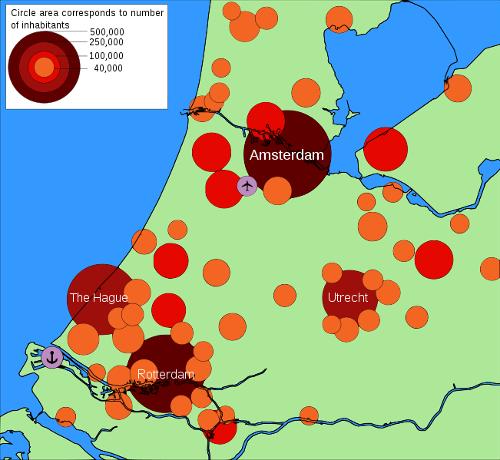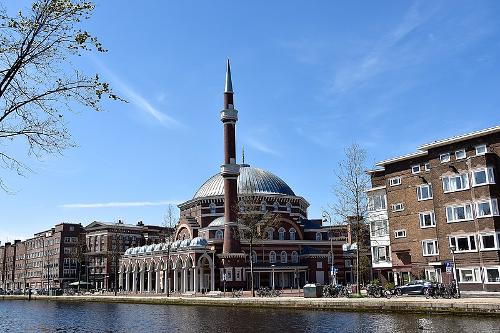NETHERLANDS
Population

Population

Cities in NETHERLANDS
| Amsterdam | Eindhoven | Maastricht |
| Rotterdam | The hague |
Population
General
 Randstad concentratuion of inhabitants of the NetherlandsPhoto:Junuxx CC 3.0 Unported no changes made
Randstad concentratuion of inhabitants of the NetherlandsPhoto:Junuxx CC 3.0 Unported no changes made
In 1830, the Netherlands had only 2.6 million inhabitants. In 1996 the Netherlands had 15,460,000 inhabitants and in March 2001 the sixteen millionth inhabitant was born. In 2024, the Netherlands had about 18 million inhabitants. This makes the Netherlands one of the most densely populated countries in the world (approx. 500 inhabitants per km2) and the most densely populated country of any size in Europe. The largest increase took place in the post-war period from 1945 to 1990, at 6 million.
The west, especially the Randstad with cities such as Amsterdam, Rotterdam, Utrecht and The Hague, is the most densely populated area with almost 1000 inhabitants per km2. The most sparsely populated is the north with about 190 inhabitants per km2. The south and the east have approximately the average population density of the Netherlands. The former island province of Zeeland is also sparsely populated with approximately 200 inhabitants per km2.
In fifteen years, the population has grown from 15 to more than 17 million. Statistics Netherlands expects the population to continue to grow to around 18 million. Population aging and a mortality surplus will gradually reduce the population over the course of the century.
The percentage of Dutch people living in cities with 100,000 or more inhabitants decreased until 1984, and has been rising again since then. 96% of the Dutch population lives in an urbanized area. (2024)
The largest cities in the Netherlands are Amsterdam, Rotterdam, The Hague and Utrecht.
The population of the Netherlands is aging at a rapid pace. For example, the number of people over 65 has grown enormously in fifty years.
Population by age in 2024:
- 0-14 jears 15,2%
- 15--65 jears 64,1%
- 65+ 20,7%
Life expectancy at birth for the male population was 80.3 years in 2024 (1950: 70.4 years).
Life expectancy at birth of the female population was 83.5 years in 2024 (1950: 72.7 years).
Ethnical minorities
 Mosque Amsterdam, NetherlandsPhoto: FaceMePLS CC 2.0 Generic no changes made
Mosque Amsterdam, NetherlandsPhoto: FaceMePLS CC 2.0 Generic no changes made
According to the Central Bureau of Statistics (CBS), there were approximately 2.25 million non-western foreigners in the Netherlands in 2024. The total number of immigrants is approximately 4 million.
In the mid-21st century it is expected that 5.9 million immigrants will live in the Netherlands. The share in the total population thus grows to just over 32% on a total population of 18 million people.
Mediterranean workers and their families came to the Netherlands after 1960 as labor migrants and were often deployed in the factories and often did the heavy dirty work. This category actually includes ten ethnic groups: Turks, Moroccans, Spaniards, Italians, Yugoslavs, Portuguese, Cape Verdeans (especially in Rotterdam), Greeks, Egyptians and Tunisians.
40% of non-Western immigrants belong to the largest two groups: Turks and Surinamese. At present, immigrants with a Turkish background form the largest group of non-Western immigrants with approximately 400,000 people.
Among Moroccans, the second generation in particular is growing strongly due to the relatively high number of children that Moroccan women have on average. Although the fertility rate will drop from 3.3 in the coming years to 2.6 children per woman, it is still much more than for native Dutch women.
The residents of Surinamese descent are both those who came to the Netherlands before the independence of Suriname on November 25, 1975 and generally have the Dutch nationality on the basis of the Allocation Agreement, as well as those who came after that date and in general a Surinamese citizen. to be.
The number of people with a Surinamese background is currently approximately 350,000.
The approximately 153,000 Arubans and Antilleans in the Netherlands are citizens of the Kingdom by virtue of the Kingdom Statute of 1954. From the mid-eighties onwards, a third stream of young unskilled Antillean migrants from the Antilles has started.
The first two streams were the Antilleans who came to study in the Netherlands and workers who looked for work in the Netherlands after the closure of the large refineries on Curaçao. Due to their low level of education and limited knowledge of the Dutch language, many Antilleans of the third stream became unemployed and subsequently ended up in crime.
The Moluccans present in the Netherlands are originally ex-KNIL soldiers (Royal Dutch East Indies Army), who came to the Netherlands with their families after the dismantling of the colonial Indian army in 1951.
The international refugees is a group of different nationalities who either came here at the invitation of the Dutch government or arrived on their own initiative and subsequently obtained refugee status after an asylum application.
The fastest growing group of immigrants is made up of people from Asian countries, especially Iraq, Iran and Afghanistan. It is expected that approximately 60% of asylum seekers will come from Asian countries.
About 1,500 gypsies still live in the Netherlands, who generally live in caravans and lead a migrant life. However, more and more gypsies are permanently settling in large mobile homes or ordinary houses.
Sources
Haafkens, M. / Nederland
Gottmer
Harmans, G.L.M. / Nederland
Van Reemst
Metze, M. / De staat van Nederland
SUN
Ver Berkmoes, R. / Netherlands
Lonely Planet
CIA - World Factbook
BBC - Country Profiles
Last updated June 2025Copyright: Team The World of Info